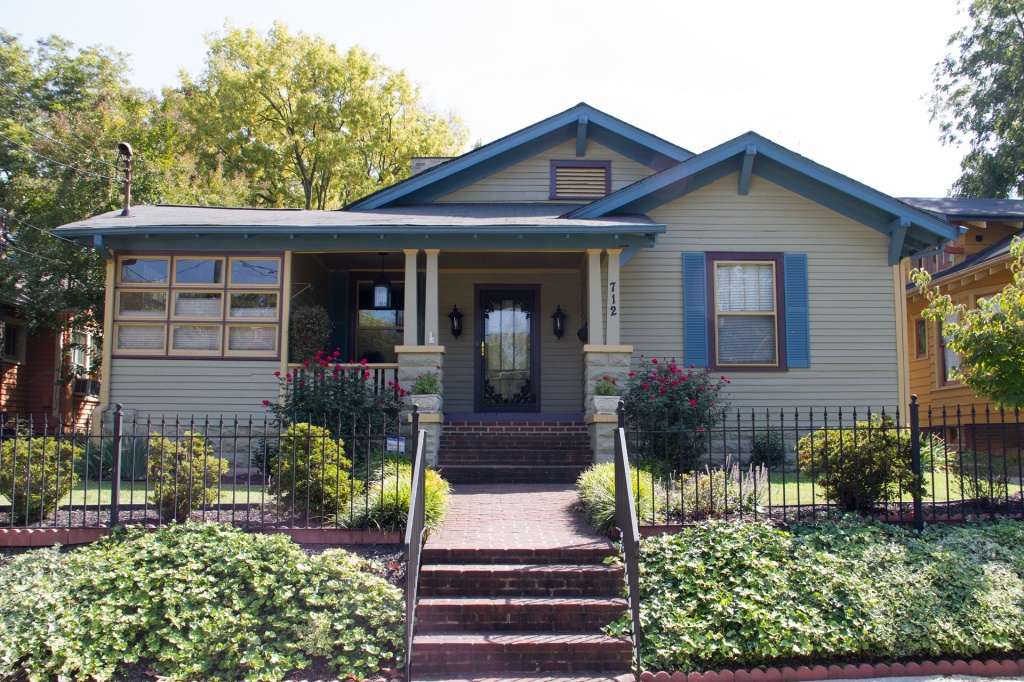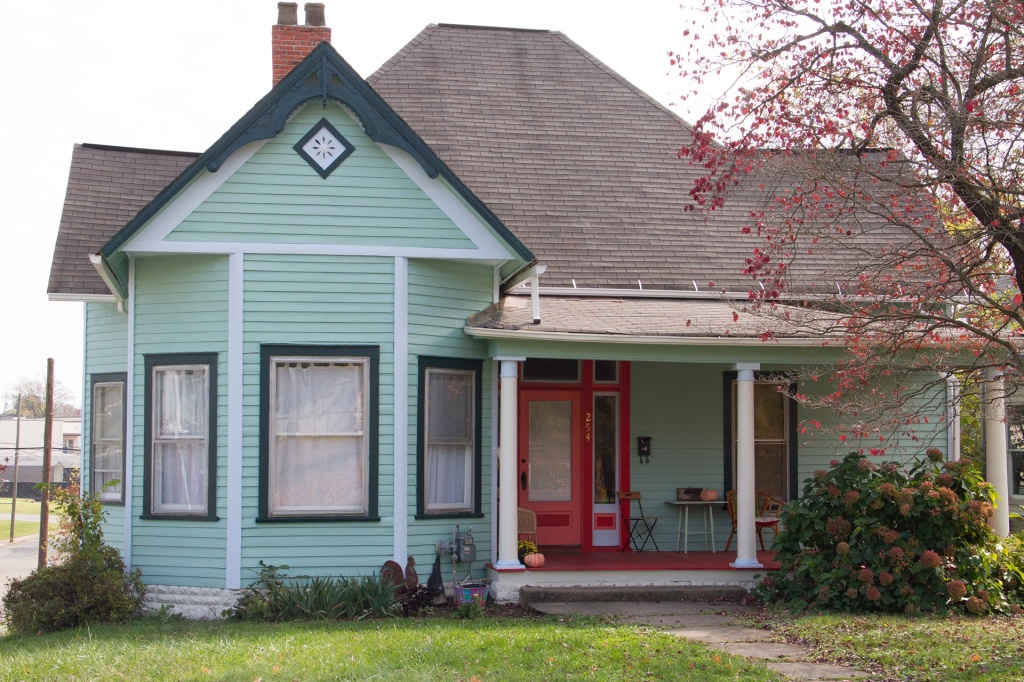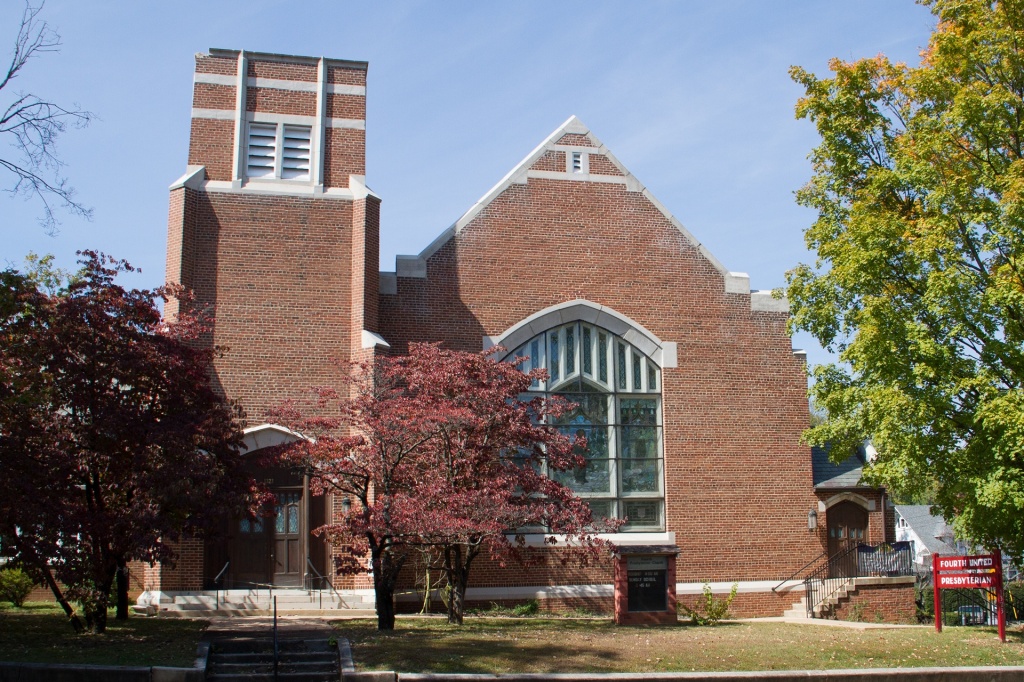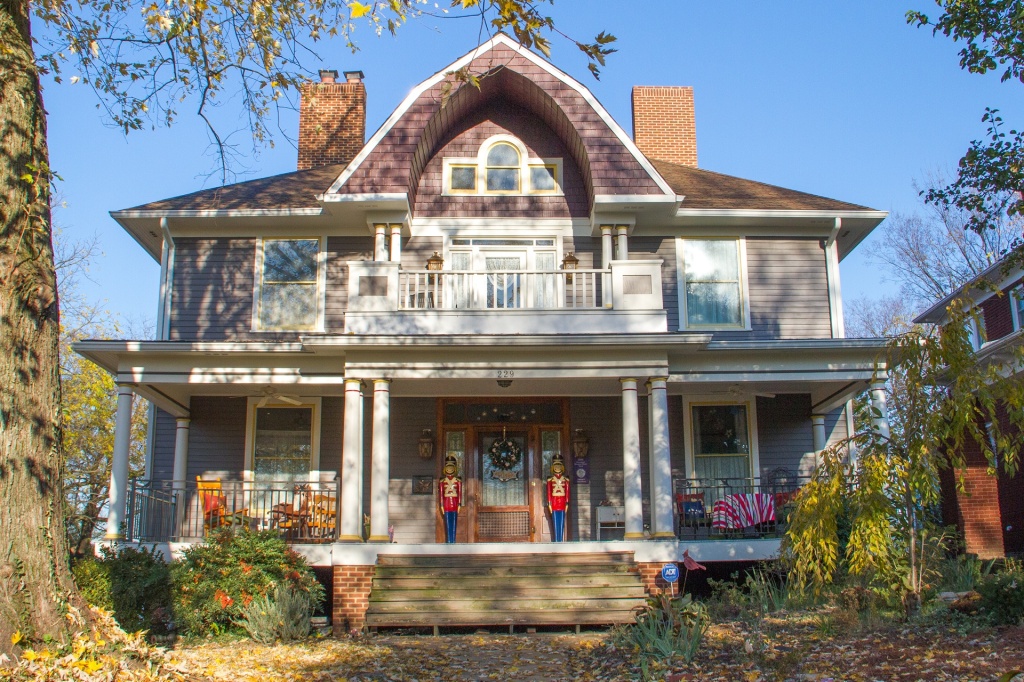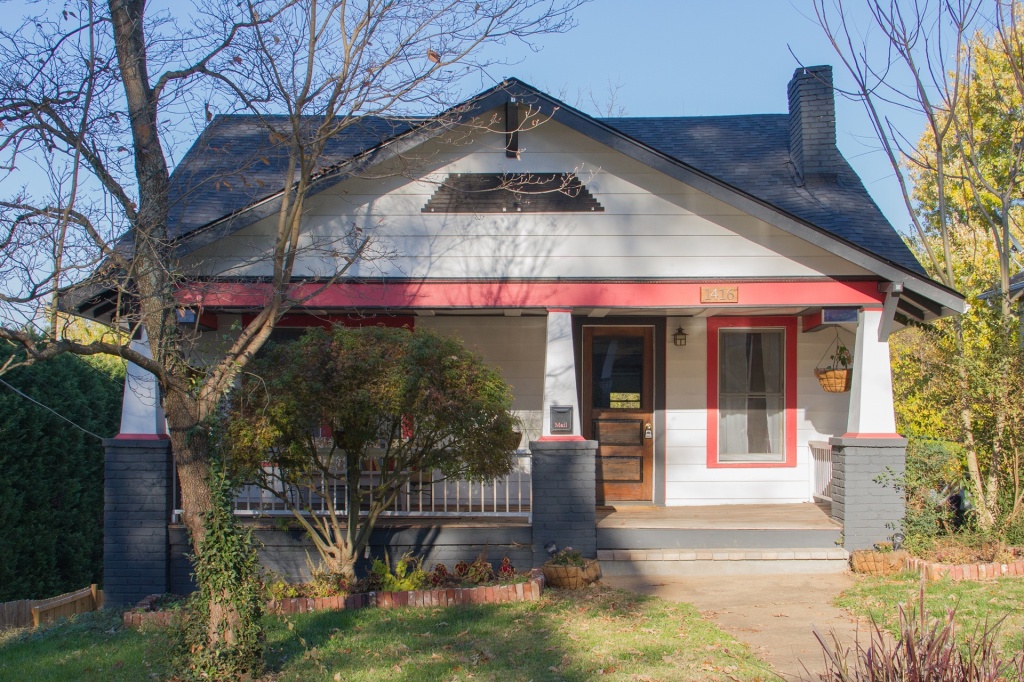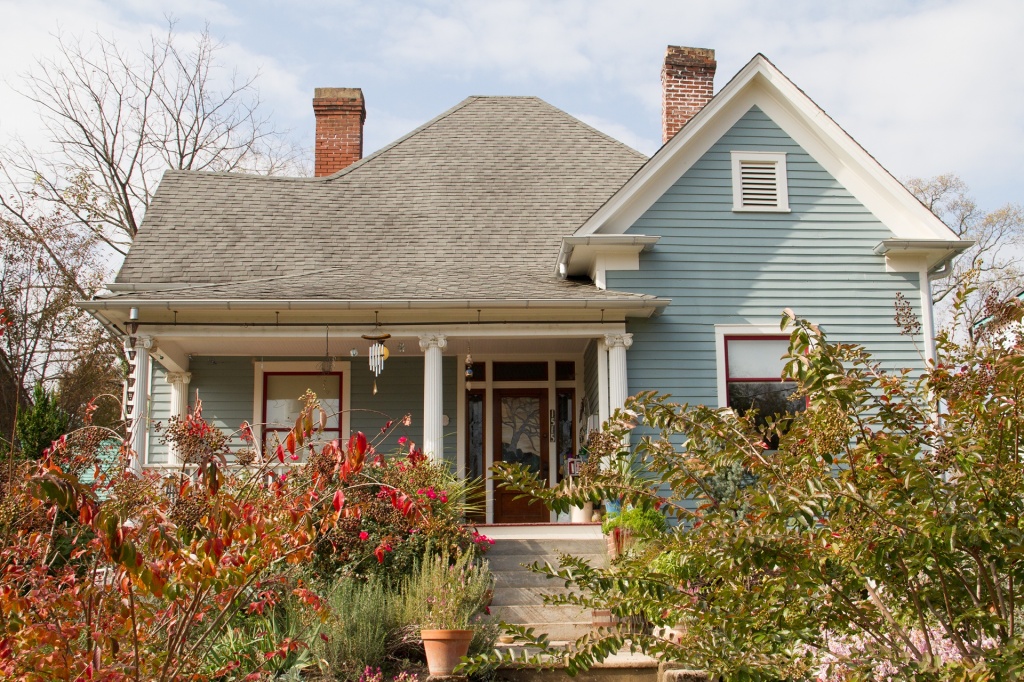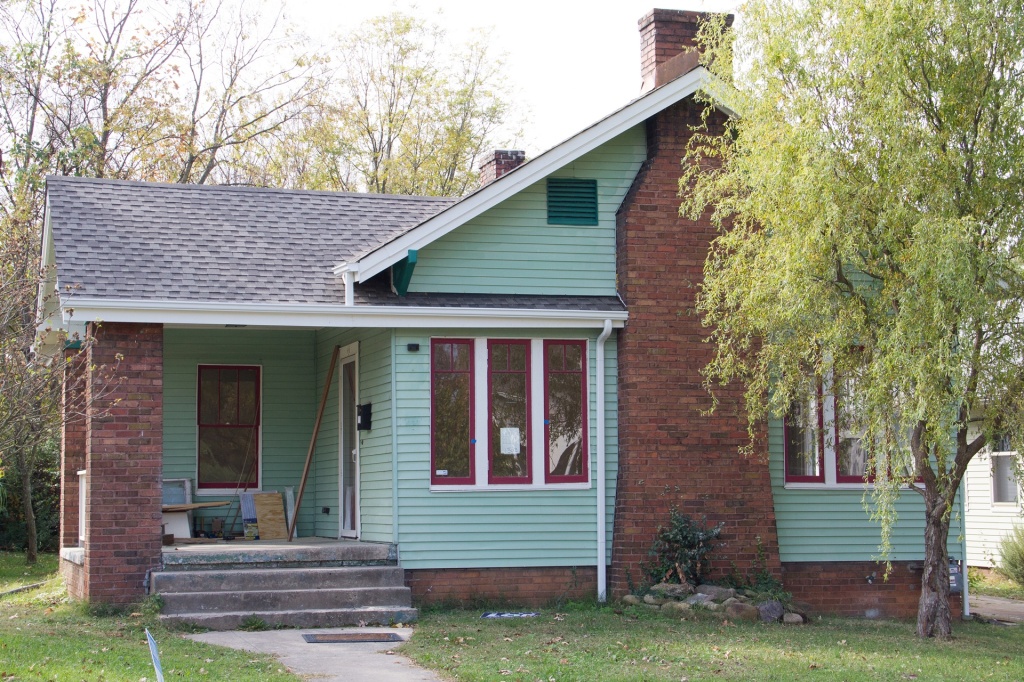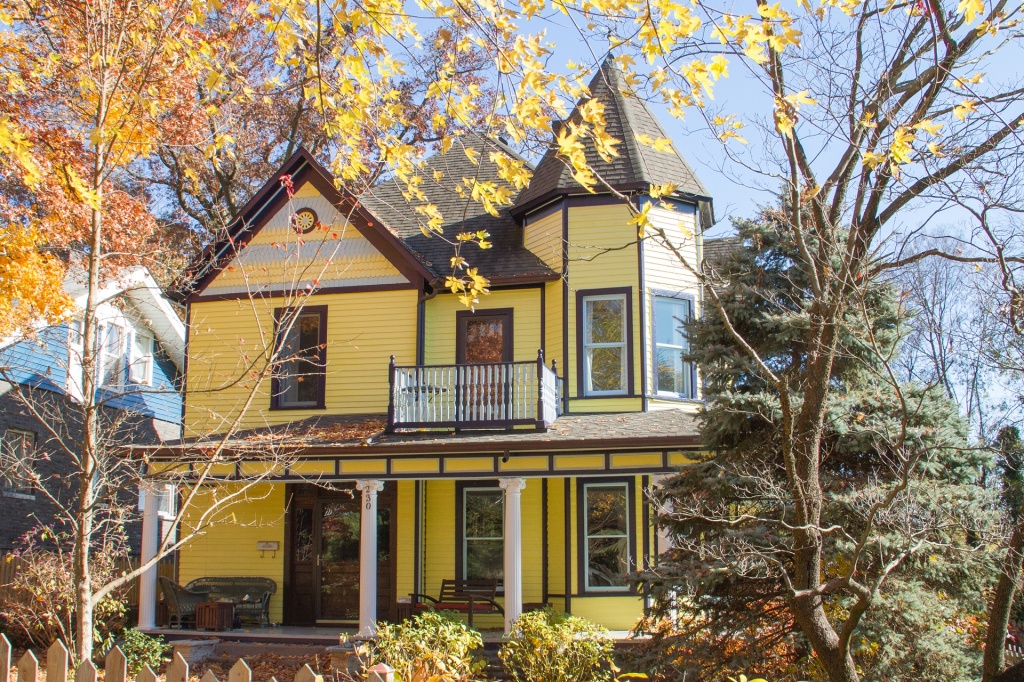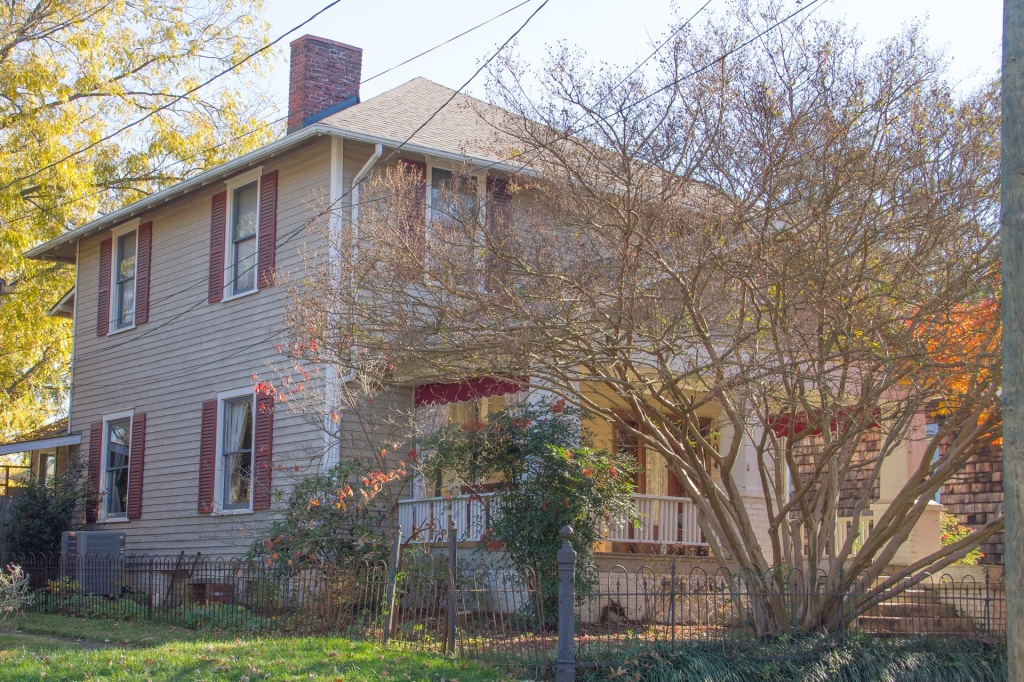712 E. Scott Avenue
This Craftsman bungalow was built in 1921 by Carl K. Robinson, a machinist for Southern Railway. The deep telescoping bracketed gables are representative of the Craftsman style, as is the cross-gabled front porch, a relatively popular composition in Knoxville. The foundation appears to be stone, but is actually cast molded concrete. Around the turn of the century, Sears, Roebuck & Co. began marketing concrete block making machines to builders and homeowners under the names Wizard, Triumph, and Knox. Why pay for brick when you could make your own ashlar-patterned cast stone using a Wizard Automatic Concrete Block Machine?
Around 1940, the house was divided front and back into two apartments – Carl and his wife Laura living in the front, and their daughter Mildred in the rear with her husband C. Granville Hunt, a photographer for TVA. Mildred sold the house in 1974 after her mother’s death.
319 E. Anderson Avenue
This warehouse building, former home of Star Vending Co., is the current home of Roberta and Sonny Jones, who have lived in Frankfurt, Germany, and in or near Detroit, Indianapolis, and Washington, D.C. Relocating to Knoxville from Virginia, they bought the building in 2005, and obtained permission from the City of Knoxville to treat it as a residence. The 4000 square foot commercial property was converted from an empty concrete box to a comfortable, spacious home, which Mr. and Mrs. Jones, with their son Colin and several cats, have occupied since January of 2006. The space has allowed the Joneses to pursue their hobbies of painting, DIY projects, quilting, and cooking. Construction of interior rooms and the installation of large windows have enhanced the livability of the building. Since the initial renovation, several modifications and upgrades have been made. Since the house was last on the home tour in 2006, a large wall has been constructed using items collected from salvage firms in Richmond, Roanoke, and Indianapolis. There are many examples of salvage and second-hand material throughout the home.
254 E. Oklahoma
This Queen Anne cottage was built in 1907 by James E. Kyker and his wife Lyda. Through the years, James Kyker served in a number of different jobs for Southern Railway – engineer, car repairman, hose repairman. Railroads were integral to the economy of turn-of-the-century Knoxville, and a good percentage of the houses in North Knoxville were occupied by families with ties to either Southern or L&N Railways. We usually think of subdivision regulations as a modern phenomenon, but part of the gracious streetscape of this portion of Old North Knoxville, the Mountain View Addition, is due to early restrictions placed in the deeds. This lot, for example, was required to have a house located no closer than 30 feet to the south line of Oklahoma, and in a denser city where corner lots were valued at a premium for their ability to be further subdivided with another structure facing the side street, the lot was also restricted to have only one house erected upon it.
Note the decorative bargeboard trim and vent in the front gable. Though certainly not as elaborate as some of its larger neighbors, even smaller Victorian houses were given a bit of style.
1323 N. Broadway
This building, the second for Fourth Presbyterian Church, was dedicated on February 17, 1914. It was completed for a total cost of $22,000. The education wing was added in the early 1950s at a cost of more than twice that of the sanctuary.
Fourth Presbyterian is noted for the architectural beauty of the sanctuary, the stained glass windows, and its Kilgen pipe organ. The church was designed by Charles and West Barber, noted Knoxville architects who were members of the church.
The history of the stained glass windows is somewhat cloudy, but it is believed that they were designed in 1912 by the Louisville Art Glass Company for a church in Ohio. The lasting brilliance of the color suggests German craftsmanship. The Ohio church chose another type of window, and the architects worked these windows into their design for Fourth Church.
A used Möller pipe organ was installed in 1914, with exposed pipes mounted in the back of the chancel. It was replaced in 1947 by the present Kilgen organ. This organ has characteristics of both theater and early 20th century organs. It is unusual in that it is “under expression,” meaning that the pipes are enclosed in chambers with shutters that open and close, allowing an exceptionally wide range of dynamics. A new Schantz console was installed in 1972, but the pipe work is almost completely original. It is the only Kilgen organ surviving in Knoxville.
229 E. Scott Avenue
This house was built in 1915 by Charles Dungan on a lot subdivided from the estate of James Fair, who had built the large Victorian on the corner to the northeast. The Dungans’s house, while borrowing some elements from the late Victorian Shingle Style, especially the distinctive front gable with the inset gothic arch, is decidedly Neoclassical with its Tuscan columns and symmetrical arrangement. The design of the gable is uncommon in Knoxville, though there is another example on Washington Avenue in Park City.
The house was a primary concern of the Mayor’s Task Force on Historic Preservation, which in 2000 issued a report recommending measures to prevent similar deterioration of other historic houses into the future. By that time, however, this house was so deteriorated, including what was commonly referred to as the “Volkswagen-sized hole” in its roof, that there seemed little chance of finding an owner willing to undertake its rehabilitation. Architect Charles Richmond and Jim Robinson took on the daunting task and restored the exterior, stabilizing the interior. Interior construction was finished by the current owners, the Riders.
1416 Kenyon Street
The wide bracketed gable front porch and tapered elephantine columns mark the Craftsman style of this bungalow, built in 1926 by Jesse D. Hughes, yard conductor for Southern Railways. Note the multi-paned windows, also a common design feature of Craftsman houses. While large panes of glass in earlier Victorian homes were a mark of prosperity because they were expensive to produce, by the time this house was constructed, smaller panes were not being used for economy, but for decorative effect.
The Hugheses lost the house during the Great Depression. It was bought in 1942 by Ernest L. Ward, a foreman for Dempster Bros. road building equipment company, and his wife Edna. They rented a room to Miss Ora Duncan, a dressmaker.
1515 Fremont Street
This Queen Anne cottage was built around 1904 by James T. Hunter, a foreman at Knoxville Coffin Company. It is sometimes strange today to think of Knoxville as an industrial city, but its location near vast reserves of timber, cheap coal, a navigable river, and major railroad lines was ideal for all manner of manufacturing enterprises. That many workers in these industries could afford houses like this one is a testament to industrial profitability.
In 1914, the house was occupied by Harry L. Miller and his wife Bess. Harry had come to Knoxville from Cincinnati in 1909, lured by its business opportunities. He worked for Tennessee Mill & Mine Supply Co. for 33 years, eventually becoming its president. After Harry’s death in 1945, Bess remained in the house for many years.
The house is a fine example of the sort of working-class housing being built in Knoxville in this time period. The form is simpler and the size smaller some other examples in the neighborhood, but the commodious front porch, the large windows, and the detailing of the gable returns combine to create the appearance of a lovely and welcoming home.
1303 Kenyon Street
This Craftsman style house was built in 1926 by Howard P. Watson and his wife Vivian. The front porch is a familiar cross-gable arrangement, but the massiveness of the brick columns and prominent battered front chimney play off the lightness of the house in a way well beyond their function. Note the unique triple casement windows on either side of the chimney.
Howard Watson was born in Knoxville in 1894. He returned to Knoxville after serving in the 114th Field Artillery during World War I, becoming a salesman for Knoxville Lithographing Company, where he worked for 27 years. The Watsons lived in the house until 1942, when they moved to Kingsport to found Watson Lithographing Company, which Howard ran for another 25 years. The house was later occupied by Hal Stroupe, a maintenance engineer for the Sears, Roebuck & Co. store nearby on Central Street.
230 E. Oklahoma Avenue
Rescuing historic buildings is sometimes accomplished through a process that stretches over several years and owners, as has been true for this two story Queen Anne home built in 1895. Over twenty years ago, the distinctive conical turret roof and second story balcony so important to the design of this building had been removed. The wood siding, shingled gables and other exterior trim details were covered with two layers of artificial siding (asbestos shingles covered by a layer of aluminum siding) and the interior stairway and details had been removed. Careful attention to the building, with selective demolition of inappropriate materials and careful replacement of original details, have brought the house back to its former glory. Extensive restoration from 2004-2012, by a past owner/architect, involved re-interpretation of interior details, including a newly created wooden staircase. This house, once divided into multiple apartments, is now a restored single family home with a wealth of historic detail that seemed lost during its days as apartments.
704 E. Scott Avenue
This house, an American Four Square with Craftsman influences, was built in 1916 by Walter A. George, a machinist for Southern Railway. The gabled front porch, with oversized elephantine columns on brick piers, the patterned wood railing, the roof brackets, and exposed rafters are all distinctive Craftsman design features. The four-square plan was often used in the early 20th century, to some extent a reaction to the excesses of Victorian design. In the case of this house, the four corners of the square downstairs – the entry hall, sitting room, dining room, and kitchen, formed the spacious public living areas for the family. Bedrooms, the private living spaces, were found upstairs. Be sure to note the elaborate beveled glass sidelights to the front door.
Walter George became an insurance agent in the late 1920s, and ran W.A. George Insurance Agency downtown for many years. He and wife Annie Hoffmeister George raised two children in the house. Annie was an active member in some of Knoxville’s social clubs in her later years – Daughters of the American Revolution, United Daughters of the Confederacy Chapter 89, and Ossoli Circle. She owned the house until shortly before her death in 1973 at the age of 91.

